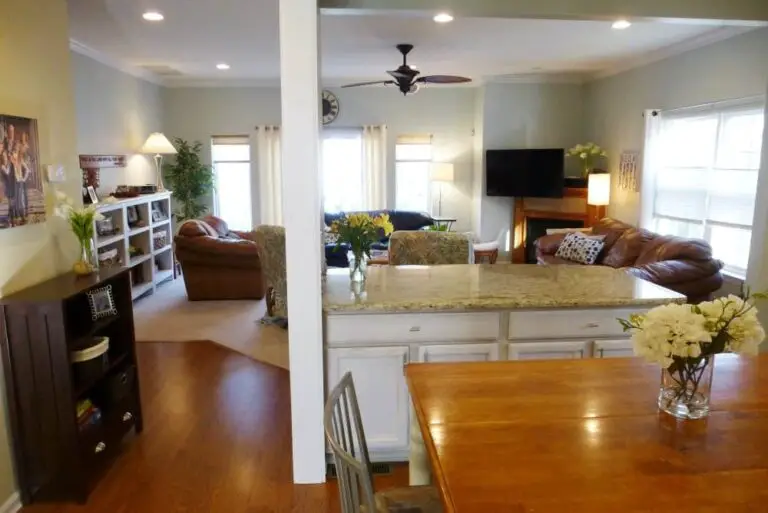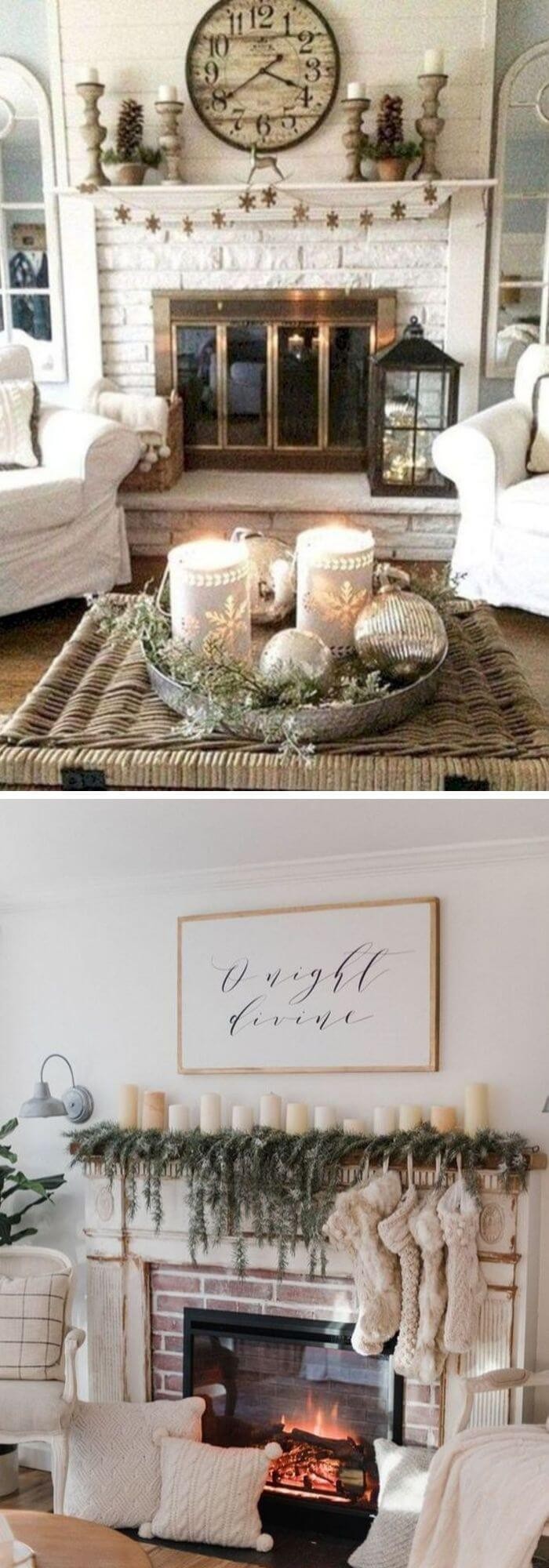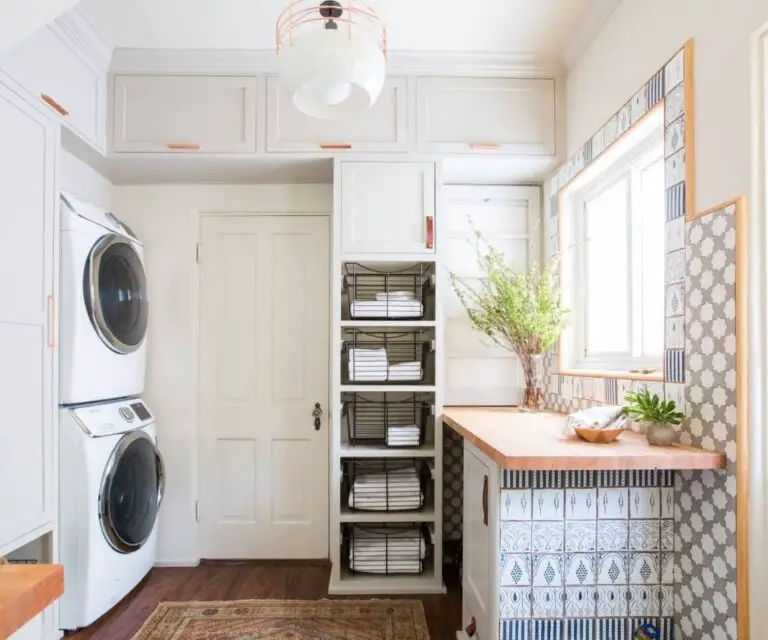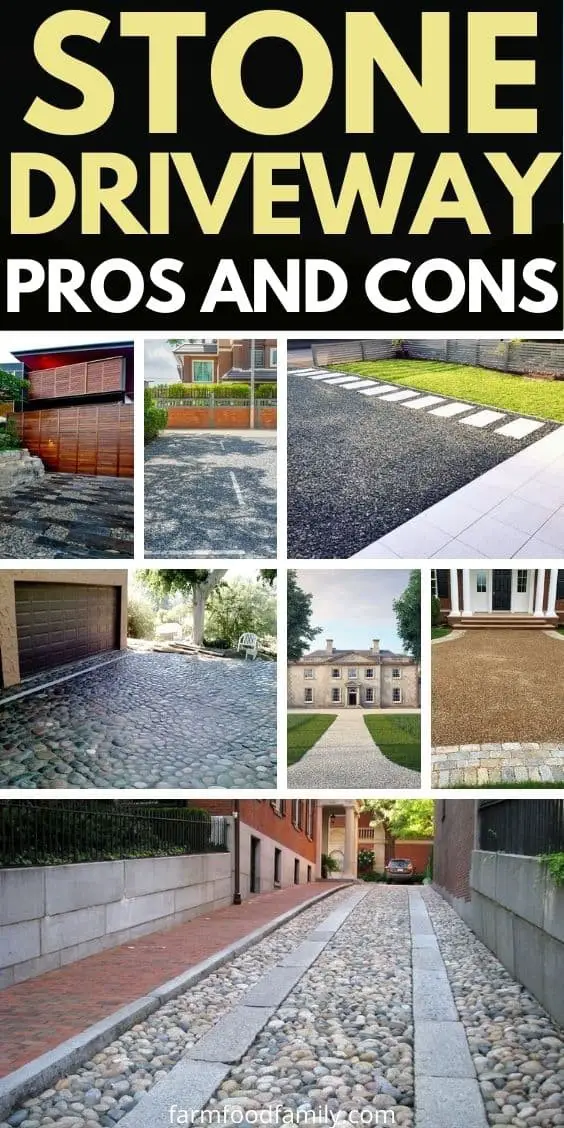14 Hot Water Heater Enclosure Ideas: Conceal & Protect
When it comes to plumbing, a water heater is an essential component of any home’s infrastructure. However, its presence can also be a visual eyesore in living spaces. Fortunately, there are numerous creative and practical solutions that can help conceal and protect this vital appliance while elevating the overall aesthetic appeal of your home. Whether you’re looking to optimize space or simply keep your water heater out of view, we’ve compiled a selection of innovative ideas that cater to diverse needs and preferences. Let’s explore these solutions together to find the perfect fit for your unique living situation.
14 Hot Water Heater Enclosure Ideas
Square metal grill
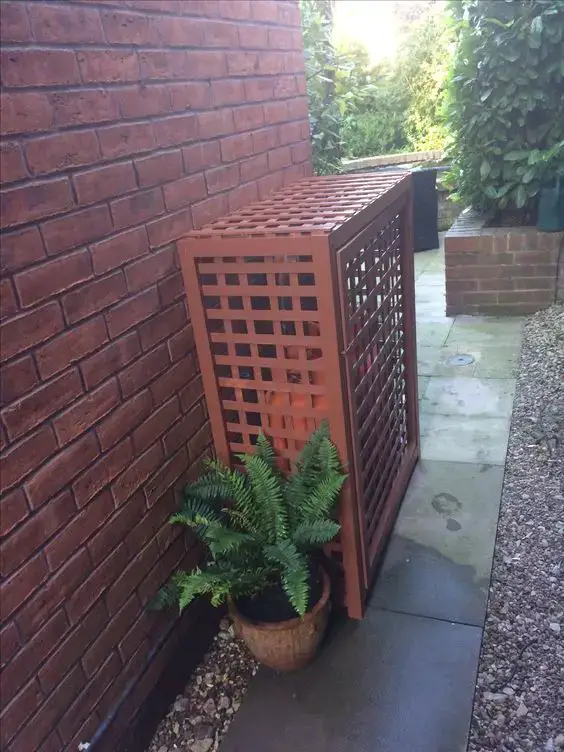
A square metal grill offers a practical and budget-friendly approach to hiding your water heater, providing optimal ventilation and airflow while concealing the unit. The versatility of this solution lies in its ability to be painted to match your desired aesthetic or left with its natural industrial look. Installation is straightforward, and the grill can be easily removed for maintenance purposes. This solution is ideal for those seeking a cost-effective means to keep their water heater out of sight.
Hanging storage unit
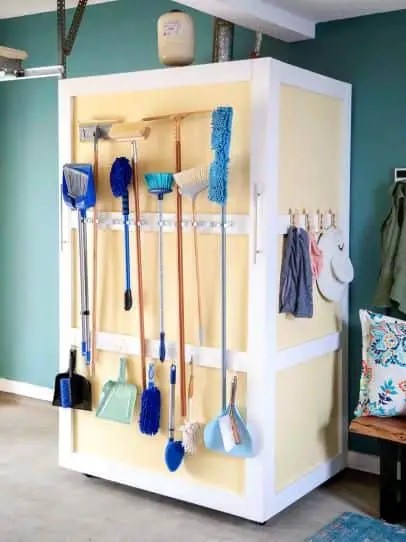
When faced with limited floor space, consider harnessing the potential of vertical storage. This practical solution not only keeps your heater out of sight but also maximizes the use of available room. By installing a shelf or storage unit, you can conveniently store items like cleaning supplies, extra towels, and other household essentials. To ensure the unit’s weight is evenly distributed and doesn’t compromise the enclosure’s integrity, be sure to provide proper support.
Bifold doors
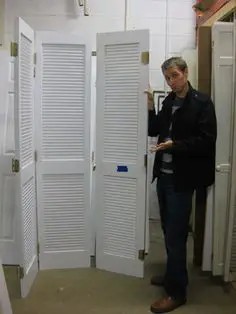
Bifold doors have become a sought-after solution for enclosing water heaters due to their user-friendly design and rapid access to the unit. With a range of materials available, including wood and metal, wood remains a popular choice. The versatility of bi-fold doors allows for customization to seamlessly integrate with any space’s aesthetic and theme. Furthermore, these doors can be secured with locks, providing an added layer of security and safety by preventing accidental access by children or pets to the water heater.
Horizontal slat wood cabinets
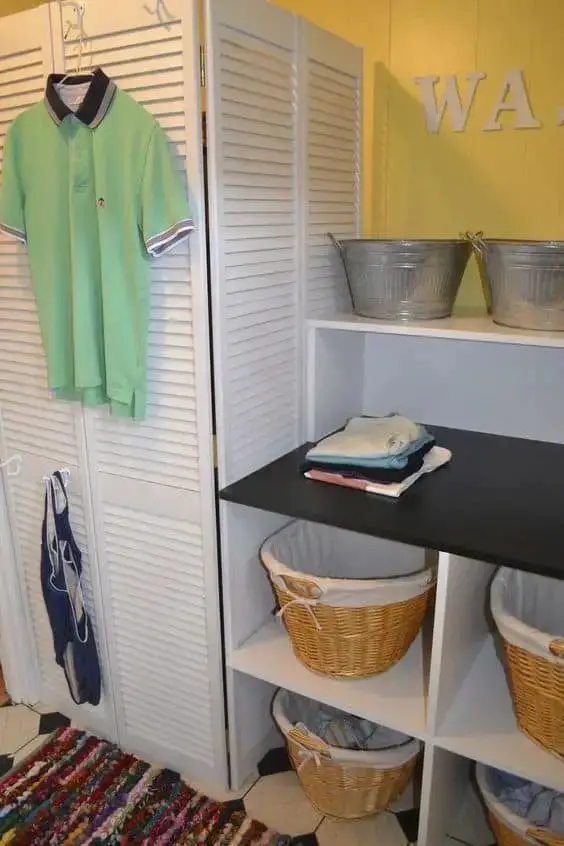
For a cohesive appearance, consider installing a custom-built cabinet made from horizontal slats of wood around your water heater. This design allows for ample storage space and can be easily painted to match the surrounding cabinetry, creating a seamless look that visually ties in with the rest of your kitchen.
Curtains
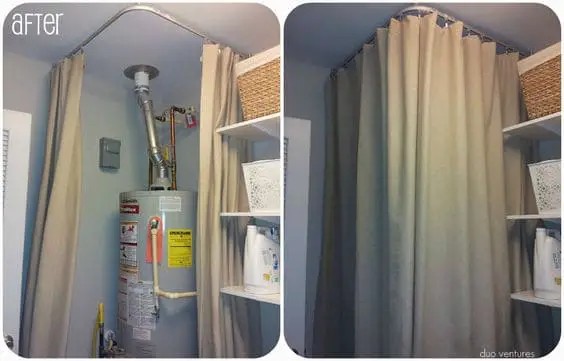
For a budget-friendly solution that’s easy to implement, consider draping curtains around your water heater. This approach is particularly suitable for renters or those on a tight budget. You can select curtains in any color or pattern that harmonizes with your existing decor, and they can be effortlessly removed for maintenance purposes.
When choosing curtains, make sure to opt for flame-retardant options to ensure their safety and durability. This will prevent them from melting away if they come into direct contact with the water heater’s heat source.
Screen
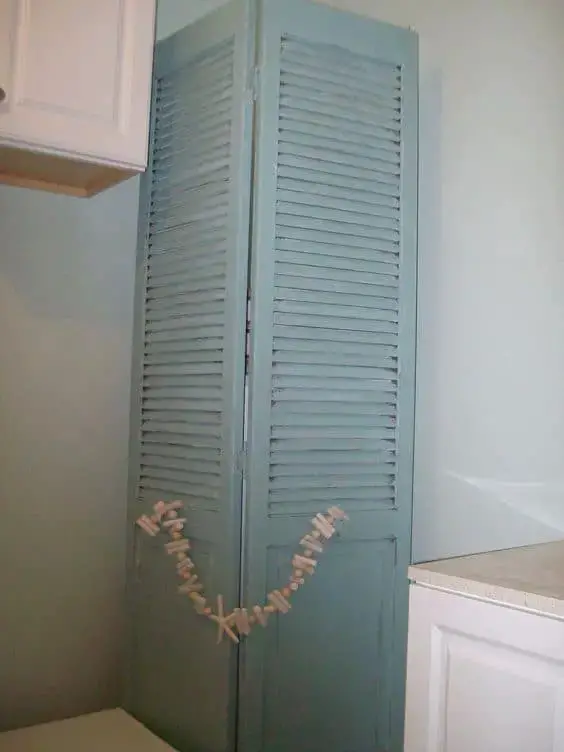
Transform ordinary household elements into stunning and practical features by injecting a dash of creativity. One way to do this is by incorporating horizontal wooden slats, which not only provide essential ventilation and airflow but also introduce a striking visual element. To further enhance the design, consider adding small planter boxes along the sides, thereby elevating the enclosure’s functionality while maintaining its aesthetic appeal.
Pallets
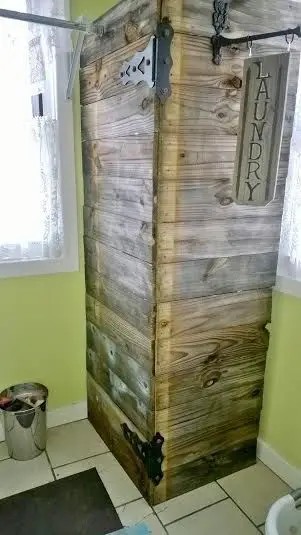
When it comes to adding a touch of creativity and affordability to a space, pallets are an excellent choice. By stacking and securing them around the unit, you can create a charming rustic look that’s sure to impress. One of the best things about using pallets is their versatility – not only can they be repurposed in various ways, but they also offer a blank canvas for artistic expression. You can either paint the pallets to match your existing decor or leave them with their natural beauty, adding a unique texture and character to the space.
Closet
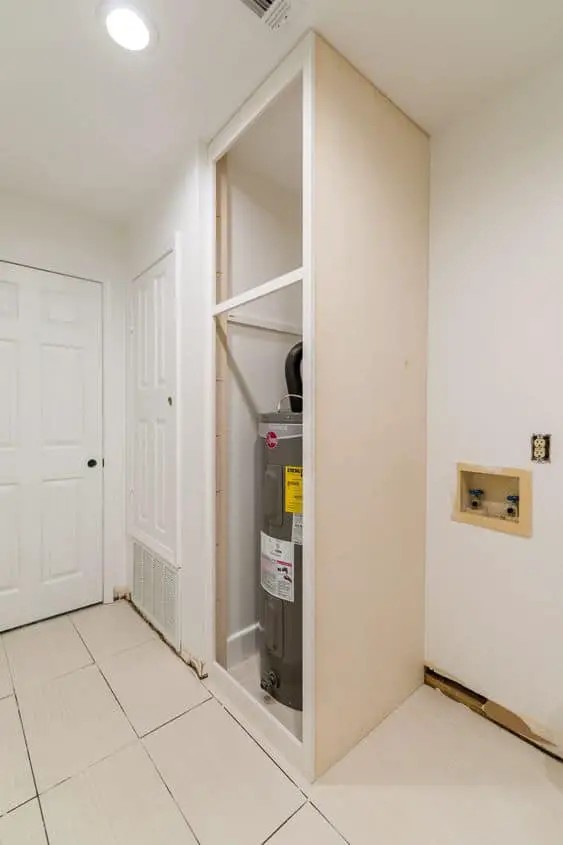
For individuals seeking to conceal their water heater from view while also benefiting from supplementary storage, this configuration presents an excellent opportunity. By incorporating shelving or rack systems, the available space can be utilized for storing essential household items like cleaning supplies, thereby optimizing functionality and minimizing visual clutter.
Faux cabinet
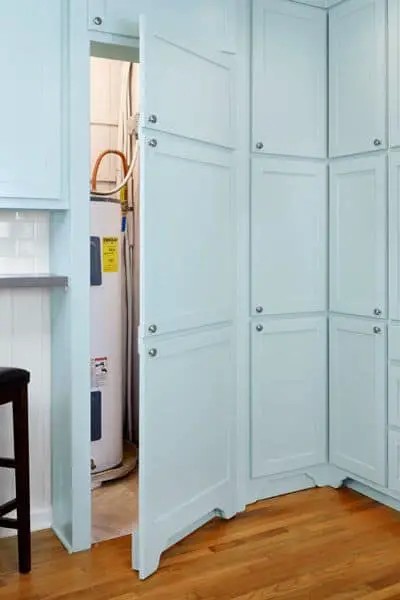
A water heater concealment strategy, sans actual cabinet installation, can be achieved through the creation of a faux cabinet. This approach involves framing the water heater and attaching doors that harmonize with the surrounding cabinetry, yielding a cost-effective and visually appealing solution that can positively impact your home’s value.
Aluminum cabinet
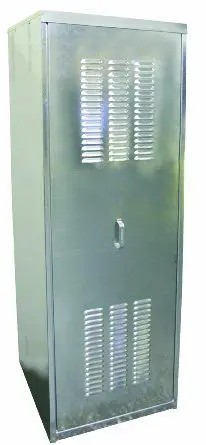
Lightweight and durable aluminum cabinets are a practical solution for housing water heaters. Their versatility allows for easy customization to accommodate various sizes of water heaters, ensuring a seamless fit. Moreover, these cabinets boast impressive resistance to rust and corrosion, making them an attractive option for outdoor installations. However, it is crucial to guarantee proper ventilation within the cabinet to prevent potential safety hazards.
Plant some flowers on it

By incorporating environmentally friendly design elements, you can not only conceal your water heater but also create a harmonious blend with nature. The wooden frame features horizontal slats that facilitate airflow and ventilation, ensuring the unit remains cool and efficient while maintaining a low profile. The natural aesthetic of wood adds warmth to the space, seamlessly integrating the enclosure into its surroundings.
Taking it a step further, the addition of a potted plant on top of the enclosure brings in a touch of greenery, fostering a sense of balance and connection with the outdoors. This thoughtful approach not only hides the unit from view but also contributes to a more sustainable and eco-friendly living environment.
Blend it with the house.
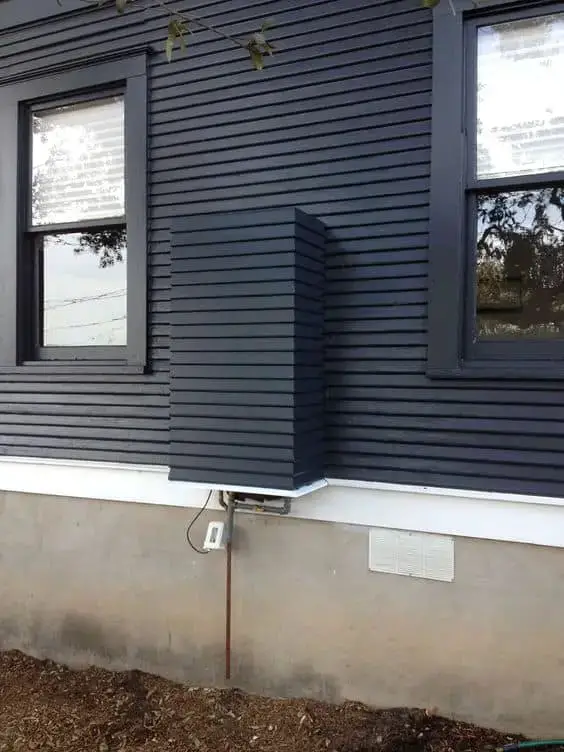
To ensure a water heater that seamlessly integrates with your home’s exterior, consider opting for an enclosure that mirrors the same siding or paint color as the rest of your house. This design choice creates a cohesive and polished look that won’t detract from the overall aesthetic of your home. By matching the enclosure to the existing exterior, you can create a harmonious visual balance that makes your water heater blend in effortlessly with its surroundings.
Frame shade

For homeowners seeking a straightforward and budget-friendly way to conceal their water heater, a frame shade is an attractive solution. This type of shading structure excels when it comes to outdoor installations, as it provides a shaded area around the unit while permitting unobstructed airflow and ventilation. Comprising a wooden frame with open sides and a roof, this design creates a sheltered zone. The beauty of frame shades lies in their minimal material requirements and ease of installation, making them an ideal choice for those on a budget. Furthermore, they can be effortlessly removed when maintenance is required, ensuring uninterrupted upkeep.
Cylindrical enclosure
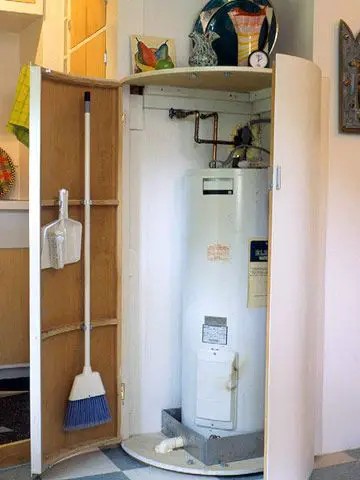
If your water heater has a cylindrical shape, there’s a design solution that can effectively accommodate it in your space. This unit can be fabricated from materials like particleboard or MDF and features a curved profile, allowing it to be nestled into a corner or other recessed area without dominating the surrounding floor space. To provide a secure fit and prevent movement, the enclosure should approximate the same diameter as the hot water tank, ensuring a snug and stable installation.
Safety First: Avoiding Flammable Items Near Heating Appliances
When handling household appliances that generate heat, it’s crucial to exercise caution and be mindful of potential hazards. One device that requires special attention is the burner access point on your water heater. While these access points are essential for proper heating system functioning, they can pose a significant fire risk if not handled correctly.
To mitigate this risk, it’s vital to maintain a safe perimeter around the burner access point, keeping flammable objects like blankets or linen at bay. Failure to do so can lead to catastrophic consequences, including property damage and even fires that spread quickly.
In addition to fire hazards, the water heater closet itself presents another set of risks. Storing items prone to moisture damage, such as books, papers, or other materials, in this environment can result in waterlogged goods and costly repairs.
Factors to Consider When Building a Hot Water Heater Enclosure
When designing a water heater cover, there are several key considerations to keep in mind. For the unit to be both secure and functional, it’s essential to remember the following crucial points: A sturdy design is critical to ensure the water heater remains stable and protected from external elements. Furthermore, consider factors such as insulation, ventilation, and accessibility to guarantee optimal performance and maintenance.
Size
When designing the hiding unit for your water heater, it’s crucial to consider the appliance’s dimensions. To ensure a snug fit within the enclosure, measure the heater’s height, width, and depth with precision. A housing that is too small can put excessive stress on the heater, which is undesirable, whereas one that is too large will occupy unnecessary space, ultimately reducing the overall efficiency of the setup.
Ventilation
Proper ventilation is crucial when it comes to ensuring maximum air circulation, thereby preventing overheating and potential fire hazards. This can be achieved by incorporating openings or vents into the enclosure, which will facilitate airflow and guarantee optimal ventilation. The size of the water heater unit and its location will dictate the placement of these vents. While it’s possible to determine the ideal setup through research and calculation, consulting with a professional is highly recommended if you’re unsure about the specific ventilation requirements for your particular unit.
Accessibility
When choosing a water heater cover, prioritize one that facilitates straightforward maintenance and repair. A top that hinges or detaches is typically the best option, as it provides unhindered access to the tank. Furthermore, consider the top’s dimensions and weight to guarantee that it can be easily lifted or removed by a single person, eliminating any potential strain or complications. Additionally, an enclosure with a door can offer added security, allowing you to lock the cover if needed – especially important for households with children.
Location of the heater
The location of your water heater within your house has a direct impact on the type of material and design used in its cover unit. If installed indoors, the enclosure typically employs moisture-resistant materials like treated wood, which resist warping or rotting that could compromise its structural integrity. Conversely, outdoor enclosures require weather-resistance and durability to protect the heater from environmental elements. In this case, materials such as metal or plastic are often preferred due to their ability to withstand rain, wind, and extreme temperatures.
Material
The choice of material used in constructing the enclosing unit significantly impacts its longevity and visual appeal. The most popular materials include wood, metal, and plastic. Wood is often preferred for its inherent beauty, but it demands regular maintenance to prevent damage from moisture and pests. While metal enclosures are durable and resistant to weather conditions, they may still corrode or rust over time. In contrast, plastic and composite materials offer low-maintenance options that can withstand moisture well, although they might not match the durability or aesthetic appeal of wood or metal. Ultimately, the decision on which material to use depends on your unique priorities and requirements for the water heater enclosure.
Conclusion
When it comes to enhancing the appearance and functionality of any home, incorporating water heater enclosure ideas is a great way to achieve both. By encasing the unit, you not only hide an often unsightly component but also facilitate easy maintenance and repair, ensuring that your hot water supply remains efficient and reliable. Furthermore, a well-designed enclosure can positively impact the surrounding area’s ambiance, making it a valuable addition to your home.
To bring this vision to life, it is crucial to consider several key factors when constructing an enclosure. These include the size of the unit, accessibility for maintenance purposes, proper ventilation to prevent moisture buildup and heat retention, as well as the material used in construction. By taking these elements into account, you can create a functional and visually appealing space that serves your home’s needs while also boosting its aesthetic appeal.


